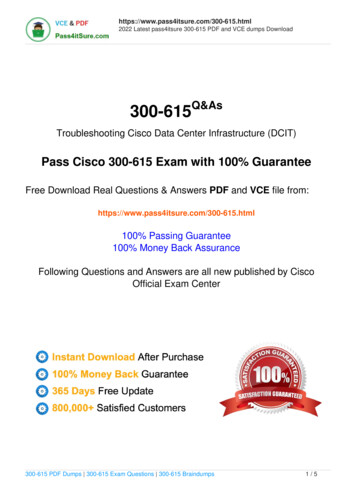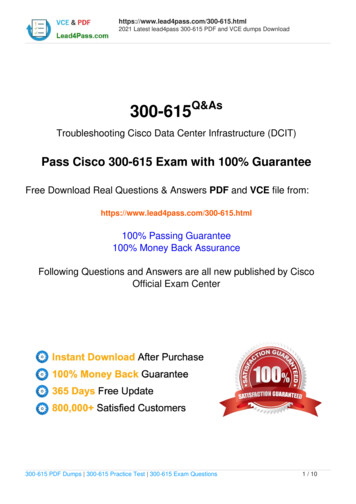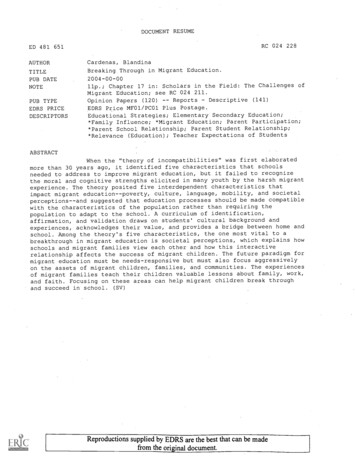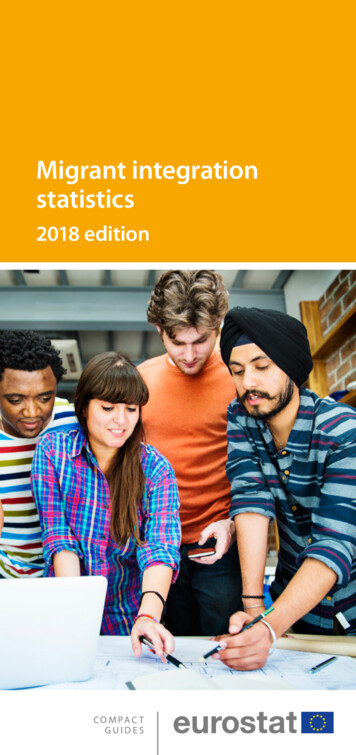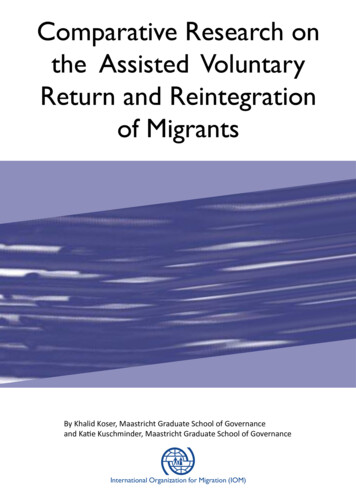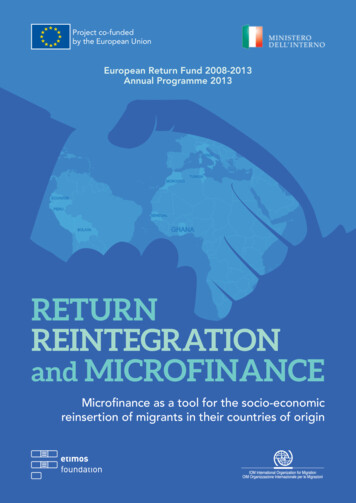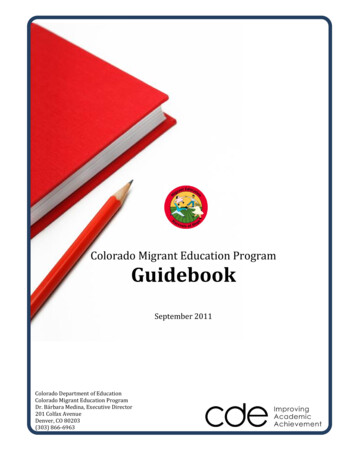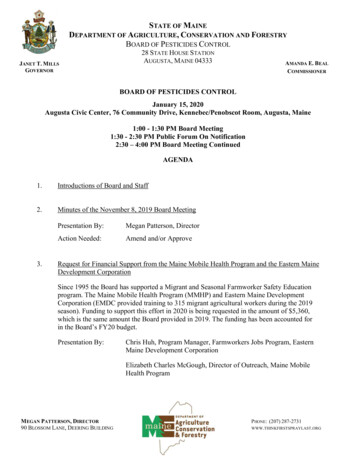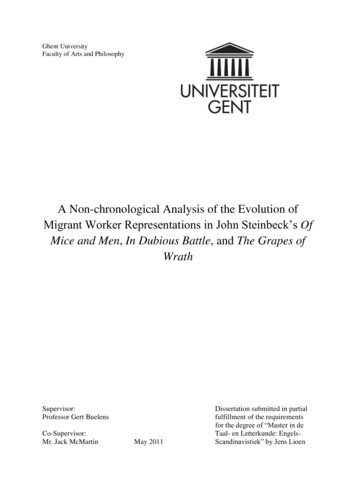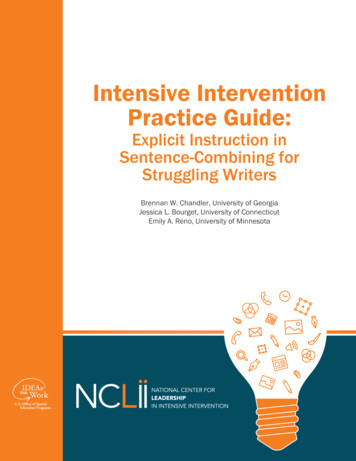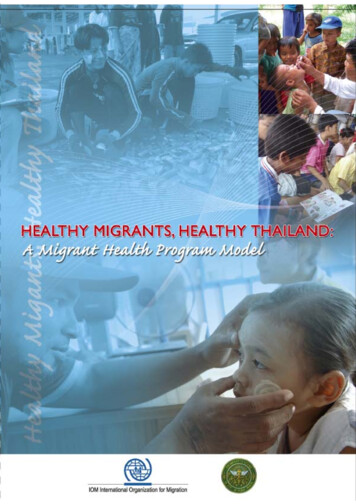
Transcription
List of Implementing Partners of MOPH-IOM Migrant Health ProgramInternational Organization for MigrationThailand MissionMinistry of Public Health:Central levelCluster of Health Services Support,Permanent Secretary OfficeBureau of Inspection and Evaluation,Permanent Secretary OfficeBureau of Policy and Strategy,Permanent Secretary OfficeDepartment of Health Service SupportChiang Rai ProvinceChiang Rai Provincial Health OfficeChiang Saen District Health OfficeMae Fah Luang District Health OfficeMae Sai District Health OfficeMuang District Health OfficeChiang Rai HospitalChiang Saen HospitalMae Fah Luang HospitalMae Sai HospitalBan Saeo Health CenterPaya Prai Health CenterHuai Mu Health CenterKo Chang Health CenterLao Lew Health CenterMae Ngoen Health CenterMae Sai Health CenterPang Mahan Health CenterPa Sak Health CenterPong Ngam Health CenterPong Pha Health CenterSob Roug Health CenterSri Don Mun Health CenterTerd Thai Health CenterWiang Health CenterPhang Nga ProvincePhang Nga Provincial Health OfficeKuraburi District Health OfficeTakuapa District Health OfficeTakuatung District Health OfficeThai Muang District Health OfficeTakuapa HospitalLam Kaen Health CenterNamkem Health CenterTanoon Health CenterTakuapa Health CenterTream Health CenterRanong ProvinceRanong Provincial Health OfficeRanong HospitalBangrin Health CenterBangnon Health CenterMittrapab Health CenterPak Nam Health CenterHin Chang Health CenterHad Som Pan Health CenterMuang Municipal Health Service UnitSamutsakorn ProvinceSamutsakorn Provincial Health OfficeSamutsakorn HospitalTak ProvinceTak Provincial Health OfficeMae Ramad District Health CenterMae Sot District Health CenterTha Song Yang District Health CenterMae Ramad HospitalHEALTHY MIGRANTS, HEALTHY THAILAND: A Migrant Health Program Model1
Mae Sot HospitalTha Song Yang HospitalBan Mae Ta Wo Health CenterHuai Hin Fon Health CenterHuai Ka Lhok Health CenterHuak Mite Pan Health CenterJa Dee Kho Health CenterMae Ku Health CenterMae Ok Pha Ru Health CenterMae Pa Health CenterMae Song Health CenterMat Tao Health CenterNong Boa Health CenterPhra That Pha Daeng Health CenterPhu To Health CenterTha Sai Laud Health CenterWong Takaein Health Center2HEALTHY MIGRANTS, HEALTHY THAILAND: A Migrant Health Program Model
ForewordThe study of migrant health program in Thailand was conducted under the collaboration among the Ministry ofPublic Health (MoPH) of Thailand, World Health Organization (WHO) and International Organization for Migration(IOM) with the objective to improve efficiency of the program. The working group reviewed the principle andstrategies of works including the overall efficiency and effectiveness of the program planning, framework, framework management and process management. The study revealed that achievement of management, technicalsupport, networking and communication among IOM, MoPH, and on-site team are achievement factors tostrengthen knowledge and improve capacity of migrant workers. The recommendations acquired from the studywill lead to improvement of efficient services and be applicable in other areas. This will ultimately raise the levelof access to health services, health improvement and well-being of migrants in Thailand.The Ministry of Public Health realized that the design of migrant health activities should consider innovative,challenged and cost-effective activities to be a good model of migrant health program. Expanding the target areasto cover unregistered migrants and those who cannot access to health services should also be considered. HealthServices should be provided actively and appropriately in line with epidemiological surveillance data in all areas.A plan should be formulated for concrete and constant development of migrant health workers and volunteersûnetwork.The Ministry of Public Health would like to thank the IOM, WHO, working gropu and all involved personnel, bothin central and provincial offices, including migrant health workers and volunteers in all areas for their contributionto the achievements of migrant health program. We hope that this lesson learnt will benefit not only migrantsûhealth in Thailand but in other countries as an experience to share among countries that have migrant workers.Dr. Prat BoonyawongvirotPermanent SecretaryMinistry of Public HealthHEALTHY MIGRANTS, HEALTHY THAILAND: A Migrant Health Program Model3
ForewordIncoming migration has been a fact of life in Thailand for some time now. The gap of socioeconomic developmentbetween Thailand and its neighboring countries, otherwise known as the push and pull factors of migration, hasmade Thailand an attractive destination for migrants, particularly from Myanmar, Lao PDR, and Cambodia. Thechallenges are vast and complex with 1.2 million labour migrants and their families, as well as an equal numberof unregistered migrants thought to be residing in Thailand.The root causes of migration into Thailand are here to stay: considering the situations in neighboring countries,it is unlikely that the push and pull factors will cease to exist in the near future. Accordingly, the Thai governmenthas had to adapt its economic, security, and social policy with the understanding that the migration issue is apermanent one. The failure to do so would mean a nation with several million marginalized people, potentiallyleading to deep social problems. There is a connection between the wellbeing of migrants and the wellbeing of thegeneral Thai population.Health is no exception to this connectivity. Despite Thailandûs strong record of public health standards, migrantpopulations remain vulnerable to various health risks, often lacking the economic means or social safety nets toaccess adequate health services. This is a concern from a public health standpoint, as sustained health problemsin a concentrated demographic often translate to issues among the wider population. In other words, the broaderThai population has a large stake in the health of migrants.The strong partnership between the International Organization for Migration (IOM), The Ministry of Public Health(MOPH) and the World Health Organisation (WHO) have been a logical response to these public health concerns.With IOMûs expertise in migrant health the MOPHûs far reaching and successful public health care system andWHOûs role with developing a migrant health information system, the three organizations have always been ingood strategic positions to address the issue of migrant health. Since its official inception in 2003 the IOM-MOPHMigrant Health Program has been utilizing the knowledge and experience of both organizations to protect thewelfare of both the Thai public and migrant population with the basic understanding that one benefits the other.As it is evident in this report, the partnership has been a great success. The MHP has been growing steadily inThailand to more provinces and as a result, more migrants have better access to public health services. It is alsoclear that there is always room for improvement. There are challenges that lie ahead: from improving migranthealth information systems to better cooperation amongst all relevant government agencies. Our hope is that thisreport will serve both as a model and lesson for migrant public health projects, and that these lessons will fostermore projects to strengthen migrant health in the future.Ms.Monique FilsnoelChief of MissionInternational Organization for Migration4HEALTHY MIGRANTS, HEALTHY THAILAND: A Migrant Health Program Model
RCKAPLao FUNOCHAUNTFHSUSAIDUSDWHOWVFTAvian and Human InfluenzaAcquired Immunodeficiency SyndromesBehavior Change CommunicationBacillus Calmette-Guerin VaccineCollaborating Center for Migrant HealthDeoxyribonucleic AcidEuropean CommissionGross Domestic ProductHuman Immunodeficiency VirusImmigration Detention CenterInformation, Education and CommunicationInternational Organization for MigrationInternational Rescue CommitteeKnowledge, Attitude and PracticeLao Peopleûs Democratic RepublicMigrant Community Health WorkerMigrant Community Health VolunteerMigrant Health Program (of MOPH and IOM)Ministry of Public HealthMemorandum of UnderstandingMedicin Sans FrontierNon-government OrganizationsProgram for Appropriate Technology in HealthPost-trauma Stress SyndromeSurveillance and Rapid Response TeamThailand Tsunami Victim IdentificationUnited NationsUnited Nations Childrenûs FundUnited Nations Office for Coordination of Humanitarian AffairsUnited Nations Trust Funds for Human SecurityUnited States Agency for International DevelopmentUnited States DollarWorld Health OrganizationWorld Vision Foundation of ThailandHEALTHY MIGRANTS, HEALTHY THAILAND: A Migrant Health Program Model5
Tables and FiguresPageTable 1 : Ministry of Public Healthûs Strategies in Relation to the Health of Migrants .15Table 2 : Summary of Program costs between 2004-2008 .44Table 3 : Number of trained Migrant Community Health Workers andMigrant Community Health Volunteers by province.46Table 4 : Number of mobile clinics conducted in four target districtsof Chiang Rai Province, 2004-2006 .52Table 5 : Perinatal care services provided to migrant women by the MHPin Samutsakorn Province, 2006-2008 .55Table 6 : Top three infectious diseases reported among migrants in the target provinces.58Figure 1 : Location of Migrant Health Program implementation sites .22Figure 2 : MOPH-IOM Migrant Health Program Structure .25Figure 3 : Collaborating Center for Migrant Health (CCMH) .26Figure 4 : Project Cycle Management of MOPH-IOM Migrant Health Program .30Figure 5 : Migrant health service system operated under MOPH-IOM Migrant Health program .33Figure 6 : Number of migrants who received health information and services fromthe MHP affiliated public health centers and migrant health/IEC corners in Ranong .53Figure 7 : Contraceptive rates among married female migrants in 4 targetareas of Phang Nga Province, 2006-2008 .546HEALTHY MIGRANTS, HEALTHY THAILAND: A Migrant Health Program Model
Table of ContentsPageExecutive Summary. 11I. BackgroundMigration into Thailand . 14The Thai Ministry of Public Healthûs Strategies Related to Health of Migrants . 15Development of MOPH-IOM Migrant Health Program . 16II.Program Description . 17Program Strategies and Activities . 17Program Site . 20Target Populations. 22III. Program Model. 24Program Structure and Operational Management . 241. Coordination Bodies .251.1 Collaborating Center for Migrant Health (CCMH) .261.2 Provincial Migrant Health Committee .261.3 District Migrant Health Team.262. Human Resources. 272.1 Central level.272.2 Provincial level .272.3 Service provider level.293. Management Flow and Operational Procedures . 293.1 Project Development .303.2 Operational Procedures.303.3 Technical Assistant and Monitoring and Evaluation .31Program Implementation Approaches and Good Practices. 321. Remote and Isolated Communities . 33Approach 1.1 Community health post.33Approach 1.2 Mobile clinic .342. Urban Community . 35Approach 2.1 Promoting access to public health facilities.35Approach 2.2 Community health post and mobile clinic.373. Workplace Intervention . 37Approach 3.1 Migrant health corners .38Approach 3.2 Mobile clinic .384. Cross-cutting Approaches . 39Approach 4.1 Community outreach .39Approach 4.2 Comprehensive programming .40Approach 4.3 Multi-sectoral collaboration .42HEALTHY MIGRANTS, HEALTHY THAILAND: A Migrant Health Program Model7
PageIV. Program Cost . 44V. Key Program Results. 45Strategy 1 : Strengthening the capacity of relevant counterparts at all levels. 45Key Result 1.1 : Government and non-government counterparts .45Key Result 1.2 : Migrant communities.45Strategy 2 : Increasing access to migrant-friendly public health services among migrants . 47Key Result 2.1 : Introduction to the concept of çmigrant-friendlyé health services .48Key Result 2.2 : Primary care and health IEC .50Key Result 2.3 : Reproductive health including maternal and child health.54Key Result 2.4 : Communicable disease control and prevention .58Key Result 2.5 : Environmental health and community sanitation .59Strategy 3 : Development of sustainable and replicable migrant health program models . 611. Program Structure.612. Human Resources .613. Co-management modality.624. Program services.625. Appropriate implementation sites .626. Multi-sectoral collaboration.627. High level of participation among various stakeholders .628. Potential for sustainability .639. Cost-effectiveness of the Program .64Strategy 4 : Strengthening collaboration among key stakeholders. 64Strategy 5 : Facilitating the development and supporting the implementation ofpositive migrant health policies . 65Strategy 6 : Strengthening community preparedness and response to potentialdisaster and/or disease pandemic. 66Key Result 6.1 : Humanitarian response for Tsunami relief .66Key Result 6.2 : Tsunami disaster victim identification .66Key Result 6.3 : Disaster and pandemic preparedness .67VI. Challenges and Lessons Learned . 70Policy and Implementation at the National Level. 701) Limited human and financial resources at all levels of the MOPH . 702) Lack of systematic development of the migrant health service system . 722.1 Lack of performance indicator for migrant health service .722.2 Employment of MCHWs.722.3 Migrant health information system .722.4 Inter-departmental coordination within the MOPH.732.5 Monitoring Program development.738HEALTHY MIGRANTS, HEALTHY THAILAND: A Migrant Health Program Model
Page2.6 Inter-ministerial coordination.743) Contradictory health and national security concerns . 74Implementation at the Field Level . 741) Migrant Characteristics . 741.1 Low level health knowledge and concern among migrants.741.2 Difficulty in personal identification among some migrant groups.751.3 High mobility among some migrant groups .752) Physical environments . 762.1 Urban setting .762.2 Rural setting.762.3 Shared concerns in both urban and rural settings .773) Cooperation from some key stakeholders . 773.1 Cooperation from business and housing owners .773.2 Cooperation from relevant agencies .774) Local health authorities and care providers . 784.1 Preparedness of relevant implementing partners.784.2 Time constraint and competing priorities .784.3 Management capacity including monitoring and evaluation .794.4 Migrant health information system .79VII. Recommendations for Future Migrant Health Programming. 80Development of a Long-term Policy and Mechanism for the Management ofInternational Labour Migrants . 80Development of Official Migrant Health Policy, Migrant Health Service, andMigrant Health Information Systems . 81Demonstration of the Transparency of the Program at all Levels. 83Scaling-up Migrant Health Services by Promoting Good Practices and Effective Strategies. 831) Capacity building and meaningful involvement of stakeholders includingthe target beneficiaries. 831.1 Public health personnel .831.2 Target beneficiaries.842) Prioritization and effective planning of migrant health services . 843) Innovative solutions. 853.1 Adjustment of health service protocols .853.2 Promoting strategic communications for behavior change .853.3 Expansion of program to hard to reach populations.853.4 Financing healthcare for migrants .863.5 Promoting low or no-cost health prevention and health promotion.873.6 Promoting community participation and responsibility in self and community care.87HEALTHY MIGRANTS, HEALTHY THAILAND: A Migrant Health Program Model9
Page3.7 The domino effect of other migration and human security issues.88Strengthening Cross-border Collaboration. 88VIII. Conclusion . 90A Clear Vision on Solutions to Migrant Health Issues and Leadership of RelevantHealth Offices. 91Commitment from all levels of Relevant Government Agencies . 91Effective Mechanisms for Program Management and Coordination . 91Meaningful Involvement of Migrants . 91Understanding and Cooperation from Thais in Host Communities . 92Reference. 93Annex. 94Annex 1. Border Health Development Master Plan, 2007-2011.94Annex 2. National Master Plan for HIV/AIDS Prevention, Care and Support forMigrants and Mobile Population (MMP), 2007-2011 . 105Annex 3. Migrant Health Strategy (draft). 111Annex 4. Background Information on Migrant Community Health Workers . 115Annex 5. Background Information on Migrant Community Health Volunteers. 11710 HEALTHY MIGRANTS, HEALTHY THAILAND: A Migrant Health Program Model
Executive SummaryThis report provides an overview and analysis of the development of the Ministry of Public Health (MOPH) International Organization for Migration (IOM) Migrant Health Program model, its strategies, progress, challenges,key results and recommendations. The purpose of the report is to document how the Migrant Health Programaddressed issues and barriers impacting on the health of migrants, and to highlight the benefits of a migranthealth system that is embedded within the existing national and peripheral levels of the public health system. It willalso consider the significant implications this has for public health security in Thailand.A range of structural and cultural factors operating at the individual and community level are closely linked to thelimited access that approximately 2.5 million migrants residing and working in Thailand have to health facilities.These factors are major constraints to improving and enhancing the health behaviors and health conditions of bothregistered and
With IOMûs expertise in migrant health the MOPHûs far reaching and successful public health care system and WHOûs role with developing a migrant health information system, the three organizations have always been in good strategic positions to address the issue of migrant health. Since its official inception in 2003 the IOM-MOPH
